

Water and Energy. Time for Electricity to Kick Its Water Habit The overreliance of US electricity generation on water has become an increasingly risky and difficult relationship to maintain in an age of weather extremes.
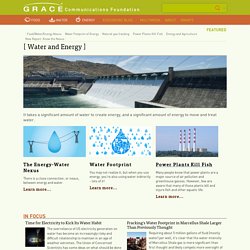
The Union of Concerned Scientists has some ideas on what should be done differently to avoid. The Water Footprint of Energy. You may not realize it, but when you use energy, you're also using water – lots of it.

Electricity and Water Use In the US, 90 percent of electricity is generated by thermoelectric power plants. These fossil- or nuclear-fueled facilities boil water for steam to turn turbines and generate electricity. Once the steam is used, it has to be cooled so it can be used again. Many thermoelectric power plants rely on “once-through” cooling technology where millions of gallons of water are withdrawn daily, before being dumped back into whatever body of water they were withdrawn from at a higher temperature. Thermoelectric power plants account for 45 percent of total water withdrawals in the US, including freshwater sources like lakes and rivers, and saline sources, such as oceans and estuaries. About 43 percent of power plants in the US still use once-through cooling systems. Once-through cooling system withdrawals can have devastating impacts on aquatic ecosystems.
Welcome to the Water Footprint Calculator. Personal water footprint calculator. The Water Footprint Assessment Manual: Setting the Global Standard (Hardback) Reviews 'Water is vital to business: poor water quality or insufficient supply can curtail - or even shut down - activities in business operations and in the supply chain.
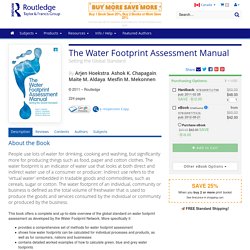
The method laid out in The Water Footprint Assessment Manual fills an emerging and urgent business need for a means of understanding water consumption in operations and in the supply chain, assessing its sustainability, and devising effective response strategies.' – Monika Weber-Fahr, Global Business Line Leader for IFC's Sustainable Business Advisory 'Forty years down the road we will have 9 billion humans living on the Earth. Nearly fifty per cent more than what we have today. The impact of any activity, be it economic or social, will have an unprecedented print on water. 'The Global Water Footprint Standard comes at a time when companies in all sectors are awakening to the risk that water scarcity poses to their bottom lines and reputations. The United Nations World Water Development Report – N° 3 - 2009 – Water ... - Google Books. The water footprint of humanity. Author Affiliations Edited by Peter H.
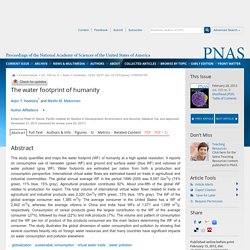
Gleick, Pacific Institute for Studies in Development, Environment, and Security, Oakland, CA, and approved December 21, 2011 (received for review June 20, 2011) 5 easy swaps to reduce your water footprint. TreeHugger recently had the chance to speak with Stephen Leahy, the author of the new book “Your Water Footprint.”
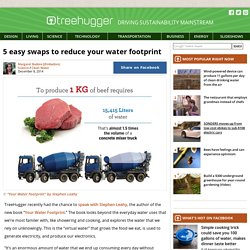
The book looks beyond the everyday water uses that we’re most familer with, like showering and cooking, and explores the water that we rely on unknowingly. This is the “virtual water” that grows the food we eat, is used to generate electricity, and produce our electronics. “It’s an enormous amount of water that we end up consuming every day without realizing it,” said Leahy. Will water footprinting help companies better manage the resource? Water is not just vital to sustain life; it's also a crucial resource for businesses.

From food and clothing to cars and mobile phones, water is an essential input. But if you don't know how much you are using or how much is available to use in a given catchment, it's impossible to reduce water use or identify threats to operations from water scarcity. In a recent survey, chief executives and world leaders said they regarded water availability in the top five global risks to business — and with good reason. Water scarcity or pollution incidents can halt production, disrupt the supply chain, lead to conflict with other water users, such as farmers or communities in the area, and harm corporate reputations.
It's imperative to get water management right, not just at head office but right along the supply chain. Water Footprints and Virtual Water. Water Footprint water footprint is quite simply the volume of water used.

At the individual level, this is expressed in litres. Water footprint - Circular Ecology. Resource-efficiency > Consumption > Standards and Labels > Environmental Footprinting > Water Footprinting. ISO 14046:2014 - Environmental management. ISO 14046:2014 specifies principles, requirements and guidelines related to water footprint assessment of products, processes and organizations based on life cycle assessment (LCA).
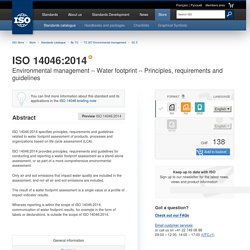
ISO 14046:2014 provides principles, requirements and guidelines for conducting and reporting a water footprint assessment as a stand-alone assessment, or as part of a more comprehensive environmental assessment. Only air and soil emissions that impact water quality are included in the assessment, and not all air and soil emissions are included. The result of a water footprint assessment is a single value or a profile of impact indicator results. Whereas reporting is within the scope of ISO 14046:2014, communication of water footprint results, for example in the form of labels or declarations, is outside the scope of ISO 14046:2014. This standard has not been revised No corrigenda or amendments available. How Can You Reduce Your Water Footprint? How much water do you use every day?
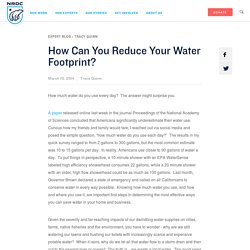
The answer might surprise you. A paper released online last week in the journal Proceedings of the National Academy of Sciences concluded that Americans significantly underestimate their water use. Curious how my friends and family would fare, I reached out via social media and posed the simple question, “how much water do you use each day?” The results in my quick survey ranged to from 2 gallons to 300 gallons, but the most common estimate was 10 to 15 gallons per day. Virtual Water - Discover how much WATER we EAT everyday.
The good news is that each one of us can also make the world a little more water secure, ready to face the needs of our peak population future.
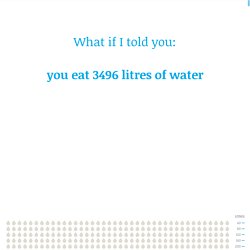
How? The answer lies in our shopping baskets. The amount of meat in our diet is crucial! Unilever global company website. We measure the water impact of our products during consumer use, which accounts for the majority of the water use associated with our products. We also include water as an ingredient in our products. We calculate our water metric annually at an absolute level as well as ‘per consumer use’, which means the water impact of washing hands with soap or doing a load of laundry for example.
For this calculation, we gather data for a large group of products that is representative of our portfolio. We include products from our five water-using categories: Hair Care, Household Care, Laundry, Oral Care and Skin Cleansing. Ca ftprint full report3. Water Footprint - Concepts and Definitions. Water Footprint Calculator. Home.